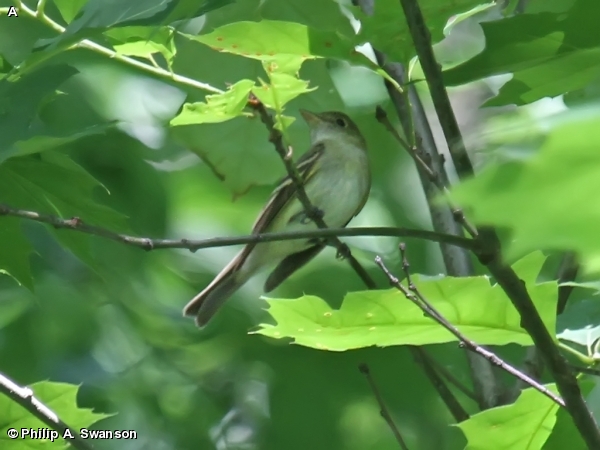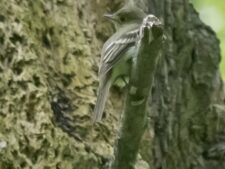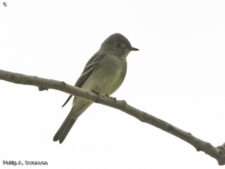
5.75 inches long. The Acadian Flycatcher is a small flycatcher with a relatively heavy wide-based bill. The eye-ring is distinct with a whitish or yellowish-white color. It usually appears relatively flat-headed with a distinct peak on the rear crown. In breeding plumage the upperparts are greenish olive from crown to rump. It is very pale below. The throat is usually white. There is a faint olive breast-band and a faint yellowish wash on belly. There are white wing bars in the adults. The wing bars are buffy in the fall. The Acadian Flycatcher is a relatively large, long-winged Empidonax characterized by especially long primary extension. The bill is the longest and broadest of any Empidonax . This is one of five small “Empids” (Empidonax Flycatchers) that may show up in the Forest. It is best identified by its call. Differences in plumage due to molt, wear and age make the plumage quite variable. It is larger than Yellow-bellied Flycatcher (Empidonax flaviventris) and Least Flycatcher (Empidonax minimus). Its color shows greener upperparts and yellower underparts than all but the Yellow-bellied. The Yellow-bellied Flycatcher is usually more yellow underneath-especially on the throat, is smaller and more active, and has a smaller bill. Alder Flycatchers (Empidonax alnorum) and Willow Flycatchers (Empidonax traillii) are browner above and whiter below with less obvious eye rings. The Least Flycatcher (Empidonax minimus) is smaller, grayer above and whiter below and has a smaller bill.
The Acadian Flycatcher breeds just south of the Omaha area and is occasionally seen in the Forest through the summer months from mid May through mid September.
The Acadian Flycatcher is a widely distributed breeder in mature deciduous forests. It is usually associated with water and found in bottomland forests, along small and large streams. This flycatcher has a shallow, flimsy-appearing nest with streamers of catkins hanging below. It forages on insects particularly on the undersurfaces of leaves. It will also hover while foraging, but also captures insects in the air and occasionally on the ground. It is easily noted by its sharp “peet-za” or” tee-chup” song.
Disclaimer: The content of NatureSearch is provided by dedicated volunteer Naturalists of Fontenelle Forest who strive to provide the most accurate information available. Contributors of the images retain their copyrights. The point of contact for this page is: Phil Swanson.


